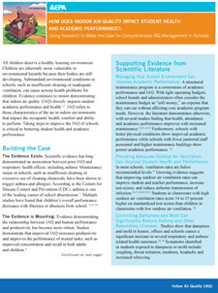How Does Indoor Air Quality Impact Student Health and Academic Performance?
- The presence of dampness and mold increase the risk of asthma and related adverse respiratory health effects in homes by 30-50 percent.
- There is evidence that modest changes in room temperature affect student's abilities to perform n tasks requiring mental concentration...
- Schools without a major maintenance backlog have a higher average daily attendance (ADA) by an average of 4 to 5 students per 1,000 and lower annual drop out rate by 10 to 13 students per 1,000.
- Children in classrooms with high outdoor air ventilation rates tend to achieve higher scores on standardized tests in math and reading than children in poorly ventilated classrooms.
Learn more: Frequently asked questions about Indoor Air Quality and Student Performance.
Recent research suggests that a school’s physical environment also can play a major role in academic performance, including:
- Leaky roofs;
- Problems with heating, ventilation and air conditioning systems (known as HVAC systems);
- Insufficient cleaning or excessive use of cleaning chemicals; and
- Other maintenance issues.
These can trigger a host of health problems — including asthma and allergies — that increase absenteeism and reduce academic performance. Research links key environmental factors to health outcomes and students’ ability to perform. Improvements in school environmental quality can enhance academic performance, as well as teacher and staff productivity and retention. To learn more, read the Quick Reference Guide for Student Health and Academic Performance. (PDF)
| Academic Performance | Academic Performance Index |
The measure of school quality, and school districts are always looking for ways to improve their performance. They focus on:
| A metric that is frequently calculated based on standardized test scores. Factors such as attendance and graduation rates may be considered as well. Factors included for measurement vary by state. |
Read About
- The latest scientific data on indoor environmental quality, health and academic performance.
- Examples of school districts that have successfully coordinated and integrated IAQ maintenance and health programs to provide evidence from the field.
- Recommendations on what you can do to help you move forward towards a better indoor environment for your school.

